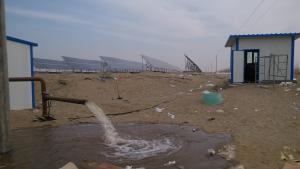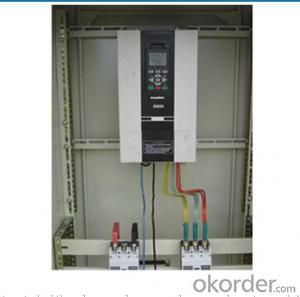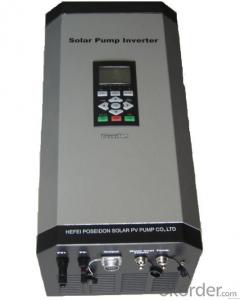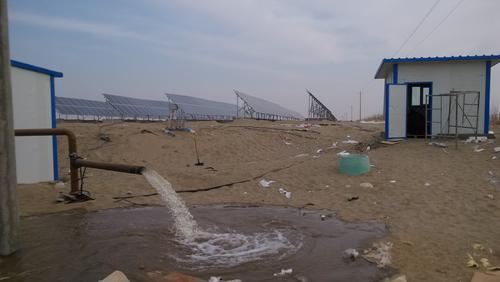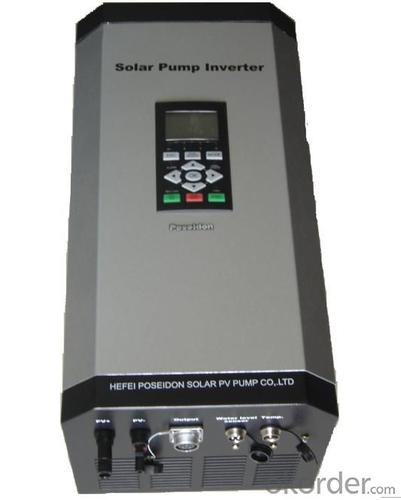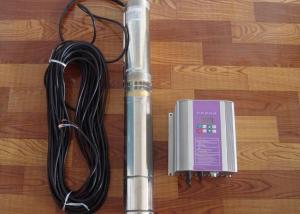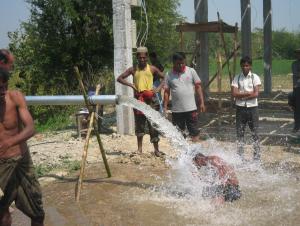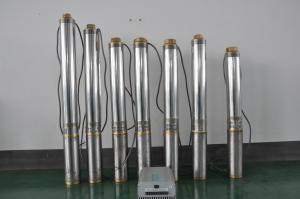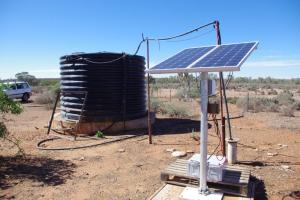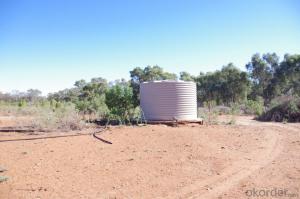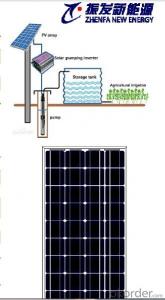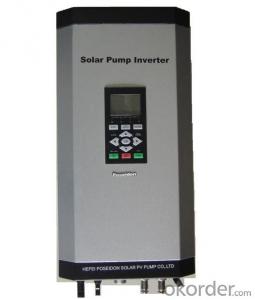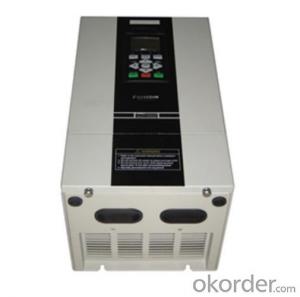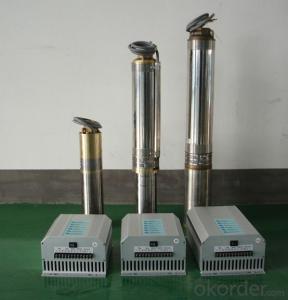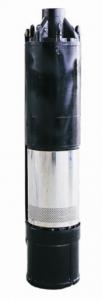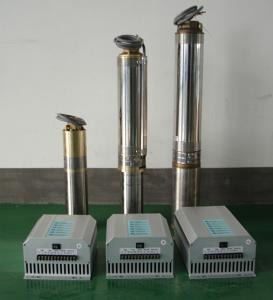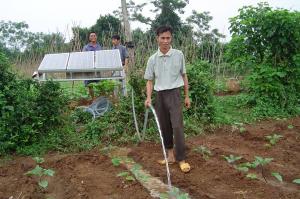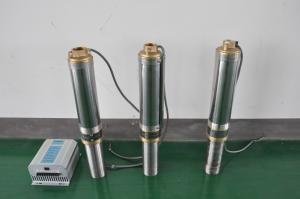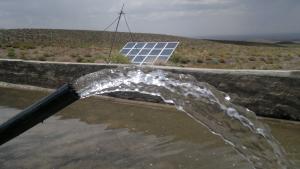Smart Solar Pump FCPM110KH Inverter
- Loading Port:
- China Main Port
- Payment Terms:
- TT OR LC
- Min Order Qty:
- -
- Supply Capability:
- -
OKorder Service Pledge
Quality Product, Order Online Tracking, Timely Delivery
OKorder Financial Service
Credit Rating, Credit Services, Credit Purchasing
You Might Also Like
Solar pump inverter FCPM110KH Product Description:
Solar water pumping system is constructed with solar panel array,solar pump inverter and AC water pump, DC current produced from solar panel will be delivered to solar pump inverter,and it will convert it into AC current to drive water pump,and will automatically regulate output frequency according to sun radiance intensity,maximally realize MPPT tracking function.
Features
Adopting the proposed dynamic VI maximum power point tracking (MPPT) control method, with fast response, and reliable operation, achieves efficiency of 99%.
Designed with variable frequency driver, greatly improves efficiency
Extremely high efficiency
Digital mode control, with automatic operation and manual operation mode options
Complete protection functions
Adopts intelligent IPM module, with high reliability
LCD display and operation panel, in real time presents operating data
Optional for water level measurement and control circuit
Applicable for general ACC pumps, like centrifugal pump, piston pump etc.
Independent intellectual property; Highly effective, the redundant reliability, exempts the maintenance and the long life.
The pumps are soft started, fully protected.
No batteries are used. So better Sunlight, more water.
Datasheet.

- Q: How do I monitor the performance of a solar pump system?
- To effectively monitor the performance of a solar pump system, there are several steps you can take: 1. Installation of monitoring equipment: Begin by installing a monitoring system capable of tracking and recording various parameters of the solar pump system. This may involve the use of sensors to measure solar radiation, pump output, battery voltage, water flow rate, and other relevant variables. The monitoring equipment can be connected to a central control unit or a data logger for data collection. 2. Establishment of performance benchmarks: Determine the desired performance benchmarks or targets for your solar pump system. These benchmarks may include the desired water flow rate, battery charge level, or pump efficiency. Clearly defined benchmarks will aid in the evaluation of whether the system is operating optimally or if any issues require attention. 3. Regular review of data: Consistently analyze the monitoring data to assess the system's performance. This can be achieved by manual analysis of the collected data or through the use of software that presents the data in a well-organized and comprehensive manner. Look for any deviations from the benchmarks and identify any patterns or trends in the system's performance. 4. Conduct periodic performance audits: Regularly evaluate the overall efficiency and effectiveness of the solar pump system through performance audits. This can involve observing the system's operation, on-site measurement of parameters, and comparison of the results with the benchmarks. Performance audits can help identify any inefficiencies, malfunctions, or maintenance requirements. 5. Utilize remote monitoring capabilities: If available, consider utilizing remote monitoring capabilities. Remote monitoring enables access to real-time data and provides alerts or notifications if any critical parameters deviate from the desired range. This proactive monitoring approach allows for early detection of potential issues, facilitating timely corrective actions. 6. Ensure regular maintenance and servicing: Make sure to regularly maintain and service the solar pump system. This includes cleaning the solar panels, checking and tightening connections, inspecting pipes and valves, and testing the overall functionality of the system. Proper maintenance ensures optimal performance and helps prevent any potential breakdowns or inefficiencies. 7. Seek professional assistance: If you are uncertain about monitoring the system independently, consider consulting with a professional solar installer or a technician specialized in solar pump systems. They can provide guidance on the specific monitoring equipment and procedures required for your system, as well as offer expert advice on troubleshooting and optimizing its performance. By implementing these steps, you can effectively monitor the performance of your solar pump system, identify any issues or inefficiencies, and take appropriate actions to ensure its optimal operation.
- Q: What is the maximum depth at which a solar pump can extract water?
- The maximum depth at which a solar pump can extract water depends on various factors such as the power of the solar panels, the efficiency of the pump, the capacity of the pump, and the conditions of the well or water source. Generally, solar pumps can extract water from depths ranging from 100 to 500 feet (30 to 150 meters) or even deeper. However, it is important to note that as the depth increases, the efficiency of the pump may decrease, and additional equipment or stronger solar panels may be required to overcome the increased resistance. Consulting with a professional or the manufacturer of the solar pump would provide more specific information regarding the maximum depth capabilities of a particular model.
- Q: Can solar pumps be integrated with existing water filtration systems?
- Yes, solar pumps can be integrated with existing water filtration systems. Solar pumps are versatile and can easily be connected to the existing infrastructure of water filtration systems, allowing for a more sustainable and efficient operation. The solar-powered pumps can provide a reliable source of energy to power the filtration system, reducing dependence on traditional electricity sources and enabling water filtration in remote or off-grid locations.
- Q: Can solar pumps be used for water supply in arid or desert regions?
- Yes, solar pumps can be used for water supply in arid or desert regions. Solar pumps are an ideal solution for such regions as they can operate using solar energy, which is abundantly available in these areas. They can provide a sustainable and renewable source of water supply, helping to meet the water needs of communities and agriculture in these arid regions.
- Q: Can a solar pump be used in areas with limited access to backup battery systems?
- Yes, a solar pump can be used in areas with limited access to backup battery systems. Solar pumps are designed to operate directly on solar power, eliminating the need for backup batteries. They can efficiently convert sunlight into energy to power the pump, making them ideal for remote locations or areas with limited access to electricity or backup battery systems.
- Q: What are the different applications of solar pumps?
- Solar pumps find wide-ranging applications in various sectors. They serve multiple purposes, such as: 1. Agriculture: Solar pumps are extensively employed in agricultural fields for irrigation. They efficiently transport water from wells, rivers, or other sources to ensure a consistent water supply for farming activities. 2. Livestock watering: Solar pumps are ideal for providing water to livestock in remote areas with limited access to electricity. They can pump water from wells or reservoirs to troughs, ensuring a constant supply of fresh water for animals. 3. Drinking water supply: Solar pumps can be used in rural or off-grid communities without reliable electricity to provide clean drinking water. They pump water from underground sources or rivers and transport it to a storage tank for treatment and distribution to households. 4. Fountain and decorative displays: Solar pumps are commonly used to power fountains and decorative water displays in gardens, parks, or public spaces. They utilize sunlight to circulate water, creating beautiful and eco-friendly water features. 5. Water circulation and aeration: Solar pumps can enhance water quality and prevent stagnation by circulating water in ponds, lakes, or reservoirs. They can also be used for aeration, promoting the growth of healthy aquatic life. 6. Drip irrigation systems: Solar pumps are suitable for drip irrigation systems, which minimize water wastage by delivering water directly to the base of plants. These systems are particularly beneficial in arid or water-scarce regions. 7. Swimming pool filtration: Solar pumps can power the filtration systems of swimming pools. They efficiently circulate water through filters, ensuring water clarity and reducing energy consumption. 8. Water supply for remote locations: Solar pumps are commonly used to provide water supply in remote locations, such as mountainous areas or islands, where connecting to the main power grid is challenging. They offer an independent and sustainable solution for accessing water in these isolated regions. In conclusion, solar pumps have a wide range of applications, serving various purposes like agricultural irrigation, livestock watering, and providing clean drinking water. Their versatility and ability to operate off-grid make them an excellent choice for different water pumping needs.
- Q: Are solar pumps suitable for all types of water sources?
- No, solar pumps are not suitable for all types of water sources. They are most effective and efficient in areas where there is abundant sunlight and a consistent water source such as a well or borehole. In areas with limited sunlight or unreliable water sources, alternative pumping solutions may be more appropriate.
- Q: Can a solar pump be used for large-scale agricultural irrigation?
- Yes, a solar pump can be used for large-scale agricultural irrigation. Solar pumps are a cost-effective and sustainable solution that can efficiently deliver water to various agricultural fields. They can provide a consistent water supply, reduce dependency on fossil fuels, and lower operational costs. Additionally, solar pumps can be integrated with advanced irrigation systems to optimize water usage and improve crop yields.
- Q: Can a solar pump be used in areas with high water table levels?
- Yes, a solar pump can be used in areas with high water table levels. Solar pumps are designed to draw water from various sources, including shallow wells, rivers, lakes, and even high water table areas. These pumps use solar energy to power their operation, eliminating the need for electricity or fuel. The depth at which the water table is located does not affect the functioning of a solar pump as long as the pump is correctly installed and the water source is accessible. In fact, solar pumps are often preferred in areas with high water table levels as they offer a sustainable and cost-effective solution for accessing water without relying on traditional power sources.
- Q: How does a solar pump handle voltage fluctuations?
- A solar pump typically handles voltage fluctuations by utilizing a built-in voltage regulator or controller. This device helps stabilize the voltage output from the solar panels to ensure consistent power supply to the pump, even when there are fluctuations in the solar energy input. This helps protect the pump from potential damage and ensures optimal performance.
Send your message to us
Smart Solar Pump FCPM110KH Inverter
- Loading Port:
- China Main Port
- Payment Terms:
- TT OR LC
- Min Order Qty:
- -
- Supply Capability:
- -
OKorder Service Pledge
Quality Product, Order Online Tracking, Timely Delivery
OKorder Financial Service
Credit Rating, Credit Services, Credit Purchasing
Similar products
Hot products
Hot Searches
Related keywords
